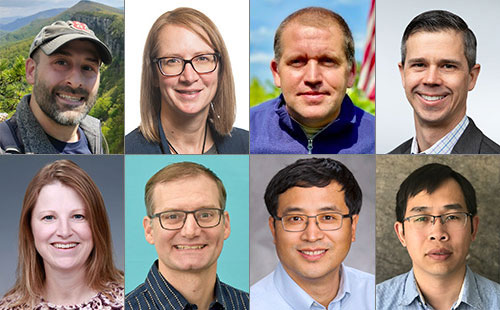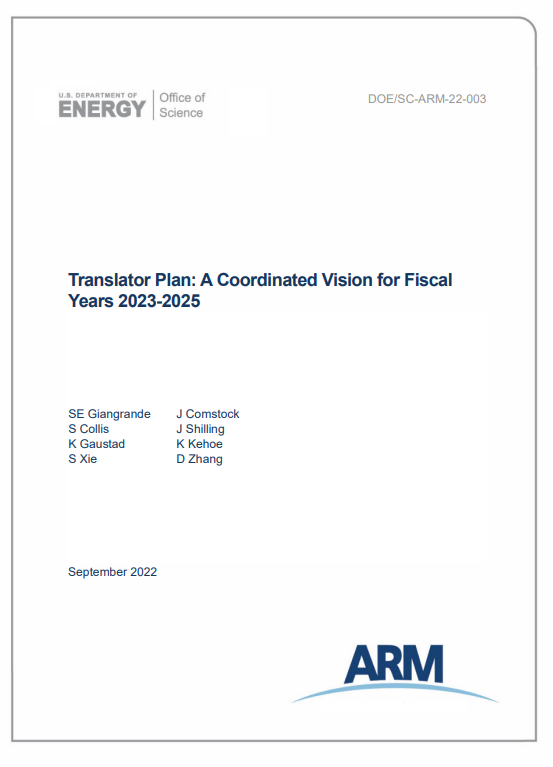New Translator Plan Sets Out Strategy for Next 3 Years
Published: 16 November 2022

The Atmospheric Radiation Measurement (ARM) user facility’s translator group, which plays a crucial behind-the-scenes role in making ARM data more useful to the scientific community, has just released a comprehensive new plan that sets out its strategy and goals for the next three years.
ARM’s “Translator Plan: A Coordinated Vision for Fiscal Years 2023–2025” provides a roadmap of where this group is headed.
The last such plan came out early in 2018. Much has been accomplished since then, yet much has changed, including the group’s personnel.
Current members of the translator group are:
- Scott Giangrande (lead translator), Brookhaven National Laboratory
- Jennifer Comstock (ARM associate director for research), Krista Gaustad (software development), John Shilling (aerosol translator), and Damao Zhang (clouds and precipitation translator), Pacific Northwest National Laboratory
- Scott Collis (clouds and precipitation translator), Argonne National Laboratory
- Ken Kehoe (ARM Data Quality Office), University of Oklahoma
- Shaocheng Xie (cloud-climate modeling translator), Lawrence Livermore National Laboratory.
Translators’ main function is creating and improving value-added products (VAPs) that process quality-controlled ARM measurements into more usable forms for science purposes such as process studies and model evaluation.
Translators are also invaluable conduits between science users and ARM infrastructure staff, keeping their ears to the ground about scientific priorities and ensuring that ARM users know about the facility’s full range of data products and services.
A key group of ARM science users is those funded by ARM’s sister organization, the U.S. Department of Energy (DOE)’s Atmospheric System Research (ASR) program. The annual Joint ARM User Facility/ASR Principal Investigators Meeting, most recently held in October 2022, is an important venue for communication between ASR scientists and the translator group.
The new translator plan is divided into two main sections: accomplishments from 2018 to 2022 and a three-year plan for prioritized new activities during fiscal years 2023 through 2025.
A Record of Accomplishment

In the last five years, translators strove to improve timely delivery of VAPs from ARM Mobile Facility deployments, including streamlining the request process and assigning a translator to liaise with the principal investigator on each deployment. They also developed new VAP capabilities to support the Aerosol Observing System and other instruments.
The meat-and-potatoes fare of translators has always been improving core VAP capabilities. ARM’s mature, robust VAPs of primary quantities require maintenance and upgrades to keep delivering high-quality, long-running data to users.
Examples include improved Constrained Variational Analysis (VARANAL) forcing data for ARM’s Southern Great Plains atmospheric observatory and a new workflow for the Active Remote Sensing of CLouds (ARSCL) VAP that speeds up its availability while increasing quality and accuracy.
The results of such activity speak for themselves. Over the last five years, new ARM datastreams doubled, as did VAP datastreams (from 116 in 2018 to 248 by the end of 2021). VAP users constitute 65% of unique ARM users: VAP downloads represent 20% of ARM file downloads.
Simultaneously, translators focused on observational‑modeling tools to reduce barriers to entry for ARM data use. Examples include support for global climate model community products, the development of Large-Eddy Simulation (LES) ARM Symbiotic Simulation and Observation (LASSO) data bundles, and improvements to the open-source Python ARM Radar Toolkit (Py-ART).
Translators also worked to improve the user experience by supporting recommended datastreams (prioritized data search delivery), datastream citation, and multi-agency collaboration with groups such as DOE’s ASR and the Global Atmospheric System Studies (GASS) panel.
If Past Is Prologue
“We look forward to the dialogue and opportunities these activities spark within the ARM community.”
Scott Giangrande, ARM’s lead translator
Projected translator activities encompass development of new VAPs and software tools, increased support for ARM Mobile Facility deployments, and further improvement of the ARM data user experience.
“We’re excited to present this coordinated vision to the ARM community—one that responds to user product recommendations, improves existing data services and the timeliness of data availability, and emphasizes the ARM user experience,” says Giangrande. “We look forward to the dialogue and opportunities these activities spark within the ARM community.”
As an example of a new VAP, Snow Water Equivalent, a precipitation product for the Surface Atmosphere Integrated Field Laboratory (SAIL) field campaign in the Colorado Rockies, will build on existing products to create new data on watershed accumulation rates.
Several new aerosol VAPs are also planned, as is an open-Python version of the workhorse ARSCL. Translators will also continue outreach to modelers through planned contacts with many organizations in this vital field. New VAPs to support modelers will round out an exciting campaign to extend ARM data usage.
Translators also plan to improve data search options by defining additional data epochs, or periods of particularly well-characterized data. This will involve working with ARM’s Data Quality Office and principal investigators to identify, tag, and group commonly ordered data sets.
Related activities will include improved data visualization in ARM’s Data Discovery browser as well as “cookbooks,” or Jupyter notebooks, which will provide better plotting capabilities.
Driving all this detailed planning has been feedback from a variety of sources. These include ARM’s Triennial Review process, Decadal Vision, and User Executive Committee, as well as ASR working groups and DOE’s Biological and Environmental Research program.
Inspirational, Aspirational
The translator group worked to pull these perspectives together into a cohesive plan that is both ambitious and achievable.
Most important, like ARM itself, the agenda is driven by the users.
“ARM just celebrated its 30th anniversary, and we translators continue to serve as the connective tissue between the science community and the facility,” says Collis, one of the longer-tenured translators. “This plan, with innovations from machine learning to open-science cookbooks, ensures ARM can remain agile and adapt to meet the needs of users present and future.”
Keep up with the Atmospheric Observer
Updates on ARM news, events, and opportunities delivered to your inbox
ARM User Profile
ARM welcomes users from all institutions and nations. A free ARM user account is needed to access ARM data.


















